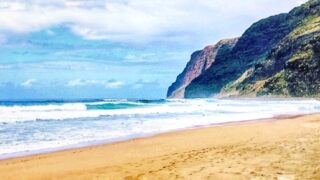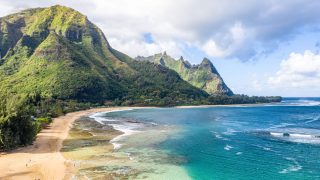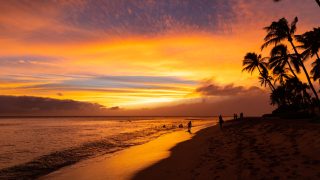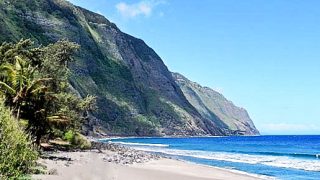Black sand beaches in Hawaii are high on many visitor lists. They show up in guidebooks, on social media, and in countless vacation photos. However, few travelers realize how different they are from what most people picture when they hear the word “beach.”
Many black sand beaches in Hawaii are challenging to access, dangerous to swim at, and best suited for a quick stop, not a whole day. Some require driving hours out of the way or walking across sharp lava to see a narrow strip of coastline. And once there, most visitors stay only long enough for a few photos before turning around.
If you expect soft sand, calm water, and a place to relax, black sand beaches usually aren’t. They’re dramatic, raw, and geologically fascinating—but they’re not what most people think.
How Hawaii black sand beaches are formed.
Black sand beaches in Hawaii don’t start as sand. They begin with lava—hot, fast, and on the move. When it reaches the ocean, the collision is explosive. The lava shatters into tiny fragments of volcanic glass and basalt, which settle into the shore and become a black sand beach if the conditions are just right. Sometimes it happens almost overnight.
But these beaches don’t last. Without a new lava flow feeding the supply, the sand disappears, washed out by storms, surf, and time. That’s why they’re so rare, and why taking a handful home isn’t just frowned on—it’s illegal under HRS §205A‑44. Every grain counts.
Black sand beaches may look inviting, but are often unsuitable for swimming. The sand is coarse and sharp, shorelines can drop off abruptly, and powerful waves and rip currents are common. These beaches also lack safety infrastructure like lifeguards or marked swim zones.
The Big Island is the black sand capital of Hawaii.
The Big Island has seven well-known black sand beaches formed by volcanic eruptions—more than any other island in Hawaii.
Punaluu Beach is the most accessible and frequently visited. Located on Highway 11 between Naalehu and Volcano, it has parking, restrooms, and picnic areas. Sea turtles commonly rest on the shore, making it popular for photos. Ocean conditions are often rough, and swimming is inconsistent. Some visitors report snorkeling when the surf is calm, usually near the parking area entry.
Richardson Ocean Park near Hilo offers a rare exception. A natural lava shelf creates a protected interior cove with calm water, tide pools, and freshwater springs. Facilities include restrooms, showers, and sometimes lifeguards. The black and green sand mix makes it one of the few genuinely swimmable volcanic beaches.
Pohoiki Beach, part of Isaac Hale Beach Park, was created after the 2018 eruption and features fresh black sand and warm geothermal ponds. Strong currents make swimming dangerous, and lifeguards are not always present.
Kaimu Beach, near Kalapana, requires walking across rugged lava fields. The sand is coarse, and swimming is unsafe due to surf and submerged lava shelves.
Kehena Beach is reached via a steep and often slippery trail and is known for spinner dolphin sightings and its clothing-optional reputation. The narrow strip of sand has no lifeguards, and waves can be unpredictable.
Pololu Valley Beach lies at the valley’s base and requires a steep half-mile hike from the overlook. There are no facilities or shade, and the ocean is unsafe for swimming.
Waipio Valley’s black sand shoreline used to be accessible, but the steep road was closed to non-residents in 2022 due to safety concerns. Visitors may only access the overlook unless joining a permitted tour or traveling with a resident.
Maui has one famous black sand beach.
Waianapanapa State Park, located just before Hana, is Maui’s iconic black sand claim to fame. The beach sits inside a state park with lava tubes, a coastal trail, and dramatic sea arches. The black sand here is finer than what you’ll find on the Big Island, and the lush backdrop makes it one of the most photographed spots in Hawaii.
Since 2021, all non-resident visitors must make a reservation to enter Waianapanapa. There is a five-dollar per person entry fee and a ten-dollar parking fee. Time slots often sell out days in advance. Due to its remote location on the Road to Hana, this is no longer a spontaneous detour—it is a pre-planned activity that takes up most of the day.
Once there, most visitors stay about thirty minutes. Swimming is occasionally possible depending on the surf, but the real draw is the setting. Still, some travelers question whether the hours of driving, parking hassle, and time limitations justify such a short visit.
One Beat of Hawaii reader noted that the beach was stunning but took most of the day, and they were back in the car before they could even dry off. That kind of trade-off has become a recurring theme.
Not all black sand beaches are equal.
One beach that often confuses visitors is Glass Beach in Kauai. Though technically not an actual black sand beach, its dark shoreline gives a similar visual impression. The beach is made partly of tiny glass fragments formed by decades of discarded bottles and surf polishing, not lava. It’s small, surrounded by industrial structures, and not especially inviting. We explored this in detail in our article on why the glass at Kauai’s Glass Beach has vanished.
It’s a reminder that “black sand beach” can mean very different things depending on where you go. And in Hawaii, expectations can often outpace reality.
Know before you go.
Black sand beaches are worth seeing, but they are rarely what visitors imagine before they arrive. These are places to witness geologic power, take a few photos, and reflect on Hawaii’s volcanic origins. They are not full-day beach lounging destinations. They are also fragile environments under growing strain from overuse and changing shoreline dynamics.
If black sand is high on your list, plan accordingly. Make reservations where needed, wear shoes suitable for rocky terrain, and do not expect easy swimming or solitude. And whatever you do, leave the sand where it is.
For more on what catches travelers off guard, read 10 things no one tells you before visiting Hawaii.
We welcome your comments on today’s post and your black sand beach experiences.
Lead Photo Credit: Beat of Hawaii at Waianapanapa on Maui.
Get Breaking Hawaii Travel News







Every trip to the BI we stay in the Waikola, Kona, or Captain Cook. Then drive around island once counterclockwise Captain Cook, Punalu’u Bake Shop in Naalehu. Very good donuts and lunch, nice outside sitting areas, and nice bathrooms. Then Punalu’u black sand to see turtles and bathrooms if needed. Volcano 🌋. Hopefully still roaring in January for next trip. Hilo and back on Saddle Rd or if have all day then all the way around to waterfalls and Fish and Hog bbq restaurant in Waimea. Pro Tip, rent a Mustang convertible or equivalent via Costco Travel and really enjoy the drive. Might be only $100 more than economy car. Reserve 6 months or more ahead and check back to see if price dropped. Then reserve another and cancel old one free.
I agree 100%. Waianapanapa is one of the most beautiful places and the world, and Punalu’u Beach is worth the visit, but they are not the kind of beaches where you loiter on the sand. The black sand beaches are photogenic, but regular beaches are more relaxing.
Great article. Every point made about black sand beaches is on point and should be considered before a visit. They are not picnic beaches, per se, but marvels nonetheless. Of all the colored beaches we have seen in Hawaii (Red, orange, black)(we have yet to see the green beach sand at Papakolea – if it’s still there) the black sand beaches are the ones we vividly remember and talk about to people who have never been. Our visit to Waianapanapa before the timed entry was a freak of nature – no one was there and we had all the time we wanted to explore. So fortunate. It’s one of our greatest family memories of Hawaii. Make the most of your 30-minutes!
I’ve been there in Maui.Its actually little black rocks,not sand.at least from what I could tell.
Article should have also talked about the Green sand beach at Papakoelo. It’s also not what people expect.
Green Sand Beach on BI. Once was enough. We hiked the 5 mile round trip thru the Sahara Desert. Could catch ride with locals 4×4 pickups instead. Same as South Point. Been there once not going to jump off cliff no way.
I miss Kapaho tide pools alot. Houses on waters edge. Very good snorkeling. Crawl from one tide pool to another and then 2018 volcano and all gone.
Great reminder. Sometimes it’s about being in awe, not in a beach chair. I’ve been to both Punaluu and Waianapanapa. Neither was great for swimming, but the photos made it all look like paradise.
Richardson Beach was the exception for us—calm enough to swim, and it felt like a real beach day. The turtles showing up made it even better.
The black sand was hotter than I expected. I didn’t bring proper shoes and paid the price. Still worth it, but definitely lesson learned.
We stopped at Punaluu and were back in the car within 15 minutes. It’s beautiful, but definitely not a swim-and-spend-the-day kind of beach.